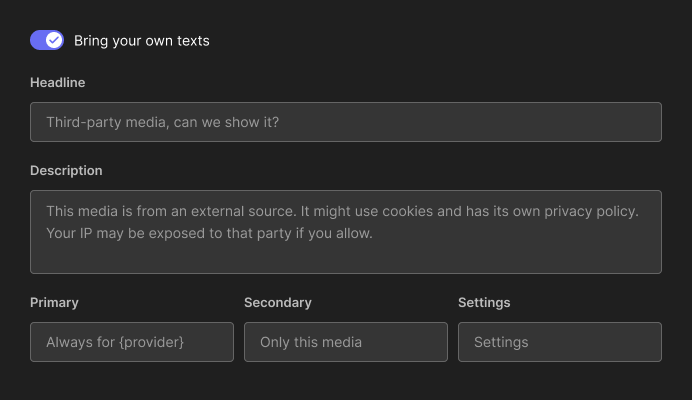User consents for third-party rich media
Iframely gives you an option to request user consent before exposing them to third-party rich media embeds. Though we do not see it as required for GDPR you might want it to be on the safe side or for its intrinsic privacy value.
If you activate the feature, all rich media will be wrapped into iFrame hosted on our iframely.net domain or your own CDN. If the user previously provided consent, we’ll show rich media without delay. Otherwise, the consent form will wait for user input before loading third-party resources.
We do not set cookies in the process. We rely on users’ local storage and handle everything solely in their browser. Chrome 115 and later partitions local storage for iframes. Iframely user consents are now unique for each hosting domain.
Example of a consent form
Set up your form
You can activate the consent form in your settings or with the consent=1 API parameter.
You may also change the design of the form in your settings.
Action buttons


The form may have one or two buttons. The scope of the consents for the buttons can be one of the following:
Per media — “Only this media”. Users will consent once for that specific rich media embed.
Per provider — “Always for {provider}”. Users will scope the entire provider. For example, “YouTube”, “Twitter”, “Facebook”, etc. We will put the provider name instead of the
{provider}string. Once the user allows any of YouTube videos, all other YouTube videos will also be allowed.Per page — “Everything on this page”. When users allow one media on a page, all other media on that page are also allowed.
Per site — “Allow all media”. Once the user allows media on your site, all media is allowed.
“Page” and “site” buttons may require some technical configuration of your web application.
If you configure the same button for both primary and secondary action, the form will have only one button.
Texts


You can change all text on the consent form to your language or your liking. Please make sure your text fits into the available space. We’ll use our default (English) texts if you leave the text fields empty.
Please keep {provider} if you want us to include a provider name into the button or anywhere in other texts.
User settings page link
This is a link inside the widget to your page where you host Iframely consents settings form as described in the next section. The link to the consents settings form is optional, leave empty to skip it.
To activate the settings link in a widget, add your text and the link to your page that embeds Iframely form.
User settings form
User may need to undo the granted consents. For this purpose, we host a simple settings form for that purpose.
Because Chrome 115 and later partitions local storage for iframes per hosting domain, Iframely standalone user settings page will no longer work. You need to embed that form on the same user domain as Iframely media widgets.
Settings page gives user access to their consents in browser’s local storage. Two contexts must match for user to have the access to proper local storage partition: Iframely CDN and your referring origin domain.
Add a dedicated page in your app to host the settings form. You can link to that page in your own documentation and can also add it as link to media widgets.
The settings form is hosted at
/consentspath of the CDN in use. If you use our default CDN, it iframely.net/consents. Please replaceiframely.netwith your custom CDN host, if use it.
<div class="iframely-embed">
<div class="iframely-responsive">
<iframe
src="https://iframely.net/consents?color={COLOR}&site={DOMAIN.NAME}"
scrolling="no"
></iframe>
</div>
</div>
<script src="https://iframely.net/embed.js" async></script>color— the hex code of accent colour of actions on the page to match your branding (please, no#to keep URL valid);site— your domain name (we’ll add “allow all” control for that domain name);theme—darkorlight, if you want a specific theme. By default, adjusts to user’s browser preferences.
Here is the consents form for our default CDN (iframely.net) and on this website (iframely.com):
Technical configuration
If you want “Site” or “Page” scope for one of your consent buttons, the widget will need to have access to the Origin and Referer header.
The corresponding consent button will not show if the request headers are not present. You need to check your site’s referrer policy and your CDN settings.
Referrer-policy
Iframely needs a unique Referer header for our iFrames as an identifier of your page. When users allow “all widgets on a page”, we check against that as an identifier.
If your website works over HTTPs, it is the default user browser behaviour for cross-origin requests to send only the host value as the Referer header. A full path may have undesirable consequences for user security and privacy.
Therefore, Referer is the same for all your pages by default, and single consent will apply to your entire website.
To avoid that problem, please change your Referer-Policy:
Referrer-Policy: unsafe-urlIf the risk of a potential leak of private information is a concern, please consider against the use of the “Page” consent scope.
Custom CDN
If use your own CDN with Iframely:
- Embed User settings form off that same CDN as the origins must match.
- If you want “Site” or “Page” consent buttons — allow your CDN to forward
RefererandOriginheaders to Iframely. - Additionally, please ensure that your CDN set up listens and allows the
refererandoriginvalues as the cache-controlvaryfield set by Iframely widgets.